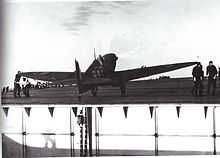Operation Bowery
| ||||||||
Operation Bowery was an Anglo-American operation in World War II to deliver Spitfire fighter aircraft to Malta ("Club Runs"). The aircraft were desperately needed to bolster the island's defence against strong Axis air raids.
Background
The operation was substantially a repeat of the earlier Operation Calendar, in which the American aircraft carrier USS Wasp had flown off 48 British Spitfire fighters to Malta to bolster its air defences. Aircraft, support personnel and airfields were inadequately prepared, however, and the enemy were forewarned of the aircraft's arrival. The aircraft had, consequently, been destroyed by heavy air attacks after their arrival on Malta.[1] A repeat delivery (Operation Bowery) had been planned and its success had become even more critical.[2]
The operation


USS Wasp returned to Glasgow on 29 March 1942, where she loaded 47 Spitfires Mk Vc[note 1][1] at King George V dock at Shieldhall. The condition of the aircraft was no better than it had been for Calendar; the essential long-range fuel tanks still fitted badly and, consequently, leaked. Wasp's captain, Reeves, refused to continue loading until the fault had been fixed on some tanks and then agreed to perform the remaining work with his own personnel. This fault had been notified to the British authorities as it had affected Calendar and its recurrence was a serious embarrassment.[3]
Wasp and her escorting force (Force W) sailed from Scapa Flow on 3 May. A further 17 Spitfires, delayed from previous "Club Runs", were transported by HMS Eagle, which joined Force W on 7/8 May from Gibraltar.[note 2][3] On 9 May 1942, 64 Spitfires were flown off USS Wasp and HMS Eagle (61 arrived). One aircraft and its pilot was lost on takeoff. Another mistakenly dropped its auxiliary fuel tank after takeoff and, now incapable of reaching friendly territory, returned to Wasp.[1]
HMS Welshman had been risked[note 3] on a high speed run to Malta, carrying, apart from food and general stores, 100 spare Merlin aircraft engines and RAF ground crews trained on Spitfires. She was disguised as a French destroyer (Léopard) and travelled independently of the main Bowery force. Welshman was intercepted and inspected twice by German aircraft but maintained a peaceful appearance and was accepted as non-belligerent; a Vichy seaplane and shore station were less easily convinced but she continued to Cape Bon and Pantellaria, finally reaching Malta at sunrise on 10 May. She unloaded amidst the mayhem of the 10 May air raid (see below) and was damaged by falling debris. Despite this, she left Valletta on the same evening, arriving back at Gibraltar on 12 May.[3]
On Malta, lessons had been learnt from the disaster of Operation Calendar and detailed preparations had been made to get the Spitfires airborne before they could become targets. On arrival, aircraft were dispersed into protected areas and rapidly refuelled and rearmed - one within six minutes of landing - and the newly arrived fighters were airborne, with fresh, experienced pilots, over Malta awaiting the air raid intended to destroy them.[1] In the resulting melée, the Italian formation (CANT bombers escorted by MC.202 fighters) was seen off[1] and 47 German aircraft were destroyed or damaged, for the loss of three British.[note 4] This air battle (sometimes dubbed the "Battle of Malta") abruptly ended daytime bombing of Malta.[3]
The defenders, further reinforced by more aircraft deliveries during May and June and aided by the transfer of Luftwaffe aircraft to Russia, retained their initiative thereafter.[1]
Notes
- ↑ Spitfires Mk Vc included modifications to streamlining which yielded a small but useful improvement, despite the added drag of a tropical air filter.
- ↑ The combined force consisted of (from Scapa) USS Wasp, battlecruiser HMS Renown, cruiser HMS Charybdis and destroyers USS Lang and Sterett, HMS Echo and Intrepid; and (from Gibraltar) HMS Eagle and destroyers HMS Ithuriel, Partridge, Westcott, Wishart, Wrestler, Antelope, Salisbury, Georgetown and Vidette
- ↑ Churchill had commented that ".. we may well lose this ship ... but in view of the emergency ... there appears to be no alternative".
- ↑ Sources are unclear whether German and Italian losses are separately totalled or combined.
References
- ↑ 1.0 1.1 1.2 1.3 1.4 1.5 Waligorski, Martin (13 Apr 2010). "1942: Defence of Malta". The Spitfire Site. Retrieved 13 Feb 2011.
- ↑ Woodman, Richard (2003). Malta Convoys 1940-1943. London. pp. 320–321. ISBN 0-7195-6408-5.
- ↑ 3.0 3.1 3.2 3.3 Woodman, Richard (2003). Malta Convoys 1940-1943. London. pp. 322–324. ISBN 0-7195-6408-5.